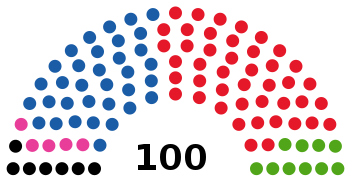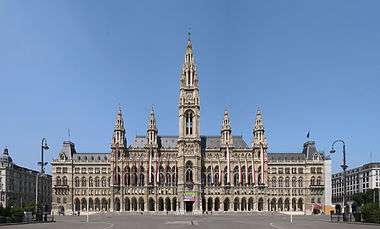Gemeinderat and Landtag of Vienna
| Gemeinderat and Landtag of Vienna Wiener Gemeinderat und Landtag | |
|---|---|
 | |
| Type | |
| Type | |
| Houses |
Gemeinderat Landtag |
| History | |
| Founded |
|
| Leadership | |
Chairman of the Gemeinderat |
Thomas Reindl (SPÖ) |
President of the Landtag |
Ernst Woller (SPÖ) |
| Structure | |
| Seats | 100 |
 | |
Political groups |
Government (54): SPÖ (44) |
Length of term | five years |
| Elections | |
Last election | 11 October 2015 |
Next election | 2020 |
| Meeting place | |
 | |
|
Vienna City Hall Rathausplatz, Vienna | |
| Website | |
| wien.gv.at | |
As a result of the dual function of Vienna as a municipality and Austrian state (city-state), the 100 members of the Gemeinderat of Vienna, the governing body of the city of Vienna, also act as members of the Landtag, the (normally unicameral) state legislature of Vienna. Members of the Landtag serve for five years.
According to the Vienna City Constitution, the business of the City of Vienna and the State of Vienna must be kept separate. Accordingly, the municipal council and the state parliament hold separate meetings, although they both consist of the same members. The representatives, when convened as a municipal council, are presided over by the chairmen of the municipal council, and can only deal with matters of the municipality of Vienna, but not the affairs of the state of Vienna. If they meet at the invitation of the President of the Landtag (not the same as the Chairman of the Council) as the Landtag of Vienna, the deputies may only deal with matters of the state, but not the affairs of the municipality. Thus, the legal situation in Vienna is different than in the city states of Berlin or Hamburg.
Gemeinderat of Vienna
The Gemeinderat, formed for the first time after the revolution in 1848 on the basis of the provisional municipal law of March 17, 1849,[1][2] issued by the imperial patent, was correspondingly enlarged in the following decades. After the incorporation of Floridsdorf in 1904/1905[3] the Gemeinderat comprised 165 representatives until 1923. The legal provisions for this were decided by the Landtag of Lower Austria as the State Law.
The municipal council could only be elected by all citizens living in Vienna after 1918. Before then, the leading classes of Vienna and Lower Austria had prevented the general right to vote, realized for men in Cisleithania in 1907, in the municipal and state policy.
In the Vienna city constitution, the Gemeinderat is mentioned before the Landtag, as was decided by the Federal Constitutional Law, which entered into force on the same day as the city constitution. It is therefore the municipal council that is the supreme collegial body of the statutory city of Vienna.
In 1923, the number of representatives in the Gemeinderat/Landtag was reduced to 120,[4] and in 1929 (first applied in the 1932 election) to 100[5] (the number it still has today).
In the Austrofascist dictatorship of 1934-1938, the municipal council was replaced by the parliament of Vienna.
The Gemeinderat elects the mayor (since November 10, 1920 also the Landeshauptmann, or governor of the state of Vienna) and the (executive) city councils since June 1, 1920, which function as members of the Viennese regional government at the same time since November 10, 1920. In addition, the Gemeinderat controls all other community bodies and decides on budget and clearance (including the state budget, which is not separate).[6] It also decides on all the city's major expenditures, the city plan, the service plan and the business division for Wiener Stadtsenat and the Viennese provincial government. It is, therefore, a very busy body, also with the municipal councils for the individual business groups of the magistrate. The municipal council is to be understood legally as an organ of the executive branch, since municipalities in Austria do not have their own legislation, but have to implement federal and state laws.
In the years from 1934 to 1945, the democratic form of government was interrupted. From 1945 onwards, the legal situation until 1934 was restored.
Landtag of Vienna
The Vienna Landtag has been in existence since November 10, 1920. On that day, the Federal Constitution passed by the Austrian Constitutional Assembly on 1 October 1920 entered into force, which defined Vienna as a separate federal state and laid down rules for the legal and economic separation of Vienna from Lower Austria. The "municipal council as a state parliament" passed the Viennese city constitution that is essentially valid up to today[7] on November 10, 1920, which was promulgated in the first edition of the state law gazette for Vienna. On 1 January 1922, the "separation law", which had been resolved by the Viennese and the Lower Austrian Landtag on 29 December 1921, entered into force. After long negotiations, the property of the former state of Lower Austria was divided between the two new states.
The Landtag has the right to legislate for provincial and constitutional laws; state competencies are determined by the Federal Constitutional Law. Legislative drafts can be introduced as government bills, by means of initiative motions (supported by at least five regional deputies) or by referendums to the Landtag. Like the other state parliaments in Austria, the Viennese state parliament is hardly active intensively, since the provincial legislature has only a few competences. The existence and size of the state parliaments have therefore led to controversial discussions for several years. The controversy has little interest in the Viennese parliament, however. since its deputies are mostly active as municipal councilors.
Meeting place
Until June 20, 1885, the Gemeinderat met in the meeting room in the Altes Rathaus, which is now used by the District Authority of the 1st District, Innere Stadt. Since then, the Gemeinderat has been meeting in the (New) Rathaus, completed in 1883, and as the Landtag since 10 November 1920. The city hall was originally equipped with its own carriage ride from Friedrich-Schmidt-Platz. From it (today one of the council entrances) the stairs 7 and 8 lead directly to the sitting room on the first floor. Upstairs are the accesses to the visitor gallery of the meeting room.